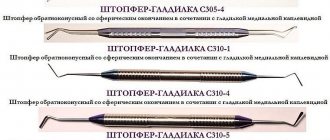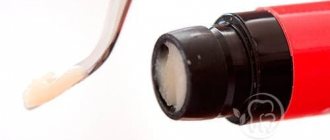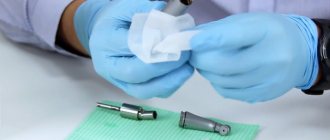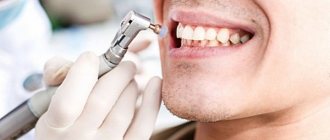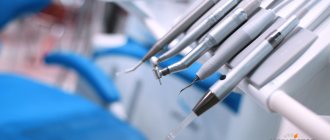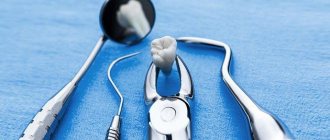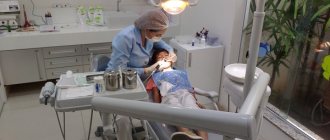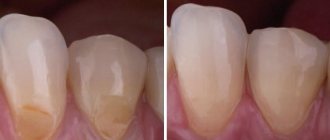Quality dental instruments
— guarantee of effective work of the dentist and safety of the patient. Each instrument that a doctor works with must meet the highest requirements and meet international quality standards. In this case, not only treatment, but also dental prosthetics, as well as any surgical interventions will be successfully completed.
In each area of dentistry - be it therapy, endodontics, surgery, implantology - certain types of dental instruments are used.
Set of instruments for examining the oral cavity
Instruments for examining the oral cavity - a basic dental set - consists of a tray for instruments, a magnifying mirror, tweezers with a curved handle, with which the dentist performs all the necessary manipulations in the most inaccessible places, a metal probe with a straight and curved (angled) sharpened blade, thanks to in which the doctor accurately recognizes caries and determines the depth of the fissures.
A set of tools for examining the oral cavity also helps the doctor accurately determine the painful condition of the teeth, their mobility and other deviations in the functionality of the teeth, that is, it is the No. 1 assistant for carrying out the initial diagnosis of a wide variety of diseases of the dental system.
Dental treatment tools
Dental instruments come in several types.
For example, hand tools are represented by plugpers and smoothers, which are used to remove softened dental tissues and fill fillings.
Manual and mechanical instruments designed for working in root canals include reamers, files, root needles, dispensers, stoppers, etc. types of dental instruments.
A separate type of dental instruments are represented by burs, diamond and polishing heads, and discs - tools for drills that work in tandem with those used with handpieces.
An important role is played by auxiliary tools, such as: clamps, punches for the matrix rubber dam, strips (abrasive strips for finishing fillings), brushes for applying liquid to the teeth.
Types and purposes of dental instruments
The work of a dentist uses both a universal set of medical devices and specialized instruments necessary to perform highly targeted manipulations. There is a generally accepted classification of dental instruments:
- for examination of the oral cavity;
- for treatment and filling of teeth;
- for the preparation of filling and other compositions;
- for removing teeth and their roots;
- for removing dental plaque;
- for processing fillings and root canals.
The listed devices are universal and necessary for general dental procedures. In addition to them, dentistry uses ordinary and surgical instruments intended for highly specialized dentists: orthodontists, orthopedists, periodontists, hygienists, and technicians.
Orthopedic instruments
This type of dental instruments is represented by metal and plastic spatulas made of different materials, from plastic to metal. They can be flat or curved and are used for processing impression materials and mixing impression materials.
Orthopedic instruments also include impression trays for making plaster models, both perforated and regular, ideally repeating the shape of both rows of teeth and accurately depicting the desired area of the dental system.
Also indispensable in the work of an orthopedist are pliers for plaster and tweezers for soldering, coronal forceps, occlusal retainer, coronal removers and coronal scissors, a micrometer, tweezers for articulating paper and other types of dental instruments necessary for a specialist to professionally perform his duties.
At the same time, the better the quality, and therefore the more convenient and reliable the instruments, the more effective the doctor’s work will be and the safer and more comfortable the patient’s treatment will be.
Dental materials, requirements and classification
The main requirements for such materials are: biocompatibility, long-term and reliable connection with the tooth base, good resistance to the environment in the oral cavity, appearance.
Depending on their use, there are five main groups of materials used in dentistry.
- Toothpastes, teeth whitening products, sealants, i.e. everything that serves to prevent dental diseases;
- Restorative materials: filling, adhesive, materials for bases and gaskets;
- Materials used in orthopedic dentistry for treatment after tooth loss (both complete and partial);
- Materials used to treat malocclusion and dentition anomalies. These are materials for braces, metal wire, archwires, etc.;
- Materials from which dental implants are made and used to restore facial tissue;
Depending on the chemical composition, dental materials are divided into ceramic, polymer, metal and their alloys.
Metals perfectly withstand significant mechanical loads and conduct heat well, but the appearance of, for example, dental crowns made from them is not everyone’s cup of tea.
Ceramics and polymers are ideal for reproducing the natural appearance of teeth, and due to their low thermal conductivity, they are also used to protect teeth from sudden changes in temperature.
Often materials with different chemical natures are used in combination with each other, which makes it possible to minimize their undesirable properties and achieve the desired combination.
Dental instruments for surgery
Taking into account the specifics of this area of medicine, instruments of this type are intended for exfoliation of the gums immediately before tooth extraction, of course, the forceps themselves for removing teeth, forceps for removing the roots of teeth (elevators), as well as syringes, bayonet-shaped, straight, and angled.
Clamps, scalpels, needles and needle holders and other types of instruments for surgical dentistry are so diverse that if you want to buy one or another instrument, you need to clearly understand for what purpose you are purchasing it, and even better, consult with specialists on this issue.
Professional consultants will definitely tell you not only about all the advantages, but also the disadvantages of the group of instruments you are interested in, indicate the correct selection criteria, and tell you what you need to pay attention to when purchasing a certain type of dental instruments.
Dental surgeon tools for teeth removal
Tooth extraction is one of the most common procedures faced by patients in dental clinics. The tools of a dental surgeon are extremely diverse. The main ones among them are elevators and tongs.
| Name and description | Photo |
| An elevator is a tool for removing teeth and their roots. There are three varieties: straight, angular, bayonet-shaped. Direct elevators are effective in removing roots in the upper jaw. Angular (lateral) ones are used to extract roots removed from the lower jaw. Elevators in the form of a bayonet are necessary for pulling out dental units in the lower jaw. | |
| Dental forceps that perform various functions. To remove teeth from the upper and lower jaws, permanent or temporary, the doctor uses different types of forceps. The most commonly used are wire cutters. | |
| A curette is a medical device shaped like a spoon with sharp edges. It is used in surgery to remove damaged tissue and suppuration from the bone. | |
| A surgical scalpel used to cut soft tissue. | |
| Surgical scissors for various manipulations related to the application or removal of sutures during surgical interventions. | |
| A syringe for administering an anesthetic drug. |
In addition to all of the above, when removing incisors, canines and molars, you may need tools for separating the gums from the jaw, tweezers for transferring and holding dressing material, needles of various thicknesses and lengths, clamps and forceps for holding a surgical needle.
How to Choose Good Quality Dental Instruments
Price
High-quality dental instruments are distinguished by their price, which, in turn, depends on the material from which the instruments are made. For example, dental instruments made of stainless steel are highly wear-resistant, can withstand repeated sterilization and, accordingly, last a long time. Is it worth buying inexpensive dental instruments? This is a rhetorical question. But only if we are not talking about the deliberate acquisition of instruments that do not require sterilization, that is, disposable ones.
Brand
In this case, you should be even more careful about the quality of the product you choose. When choosing, you can rely on the name of the manufacturer and, again, on the cost. This approach to business is guaranteed to provide you with a reputation as a true professional, and the patient will feel great both during treatment and after it.
Material of manufacture
But what else says about the quality of dental equipment? If we recall cutting instruments - the role of which is very significant and great in dental practice - then, of course, it is worth mentioning abrasive materials. They are both natural and artificial. The coarse grain size of diamonds always guarantees high speed of tooth surface preparation. This advantage allows the doctor to easily and quickly cut the silicone, apply longitudinal grooves, open the cuvettes, and generally perform the required amount of work without much effort.
Durable alloys such as titanium and stainless steel, as well as steel with chromium, nickel and molybdenum, are a real guarantee against corrosion.
Sterilization
Such instruments must be able to withstand the necessary sterilization treatments of various types (steam, air or chemical). This factor is direct evidence of the high quality of the product.
Comfort
It is convenient for a doctor to work with instruments when they do not slip out of their hands, have a good grip, smooth contours that do not dig into the hand. Comfort is the most important criterion when choosing dental instruments.
Tools for removing plaque from teeth
Very often, patients turn to the dentist who want to get rid of deposits on the surface of their teeth and gums. For these purposes, tools are produced under the following names:
- Curettes. Instruments that have different shapes, which facilitates their penetration into any part of the oral cavity.
- Hooks of different shapes and sizes. Used to clean the tooth surface and gums from deposits.
- Excavators. Necessary for removing temporary fillings, pieces of food, as well as deposits that form above or below the gum, in the periodontal canals.
- Attachments for pneumatic or ultrasonic scalers. Effective in removing deposits above the gums, as well as in cleaning the area between the teeth. A device such as a scaler should not be used in the presence of subgingival deposits.
- Enamel knife. Used for polishing and giving the ideal color to tooth enamel.
- Root file. A dental instrument used in the final stage of a dental plaque removal procedure. It is used to grind the surface of the root.
It is not so easy to list all the main dental instruments used in modern medical practice. The number of devices that every specialist should have in their arsenal is steadily increasing, as treatment methods are constantly being improved, new approaches to practical activities are being developed, and the quality of services provided is growing. It is important to correctly navigate and understand the variety of existing tools, using new technologies and developments.
Where is it profitable to buy dental instruments?
You can always buy high-quality dental instruments profitably in Moscow in the Dental Market online store.
Call Dental Market by phone 8
, check the availability of the product you are interested in and receive discounts! Our manager-consultants will be happy to answer any questions you may have, help you choose the dental instruments you need, and will always tell you what types of dental instruments the company is currently running a promotion on.
“Dental Market” is an online store for those who value their work and the health of their patients.
The influence of the price of instruments on the price of dental services
Let's be honest, many of the patients of dental clinics are frightened at the sight of new and modern dental equipment, believing that dental treatment in such an institution will cost much more.
How does the average private dentistry patient think? The management may try to return the huge amount of money invested in a private dental clinic as soon as possible, so the prices here will be unreasonably high! But in practice, given competition, regulations and rules, many dentists make concessions, trying to find the so-called “golden mean”.
Speaking of Yulistom, management is constantly searching and monitoring promotions for dental equipment and materials.
They are purchased directly from manufacturers, bypassing stores with the appropriate specialization. It is thanks to this that patients of dental clinics near the Zvezdnaya and Pionerskaya metro stations in St. Petersburg are offered affordable prices for healthy teeth! And don’t let modern dental equipment scare you, it in no way affects the fixed prices of dental services (price list at the link). Moscow metro station Zvezdnaya, Danube Avenue, 23
